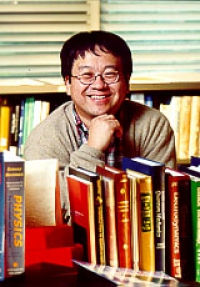Kanzo Nakayama, Professor of Physics

- nakayama@uga.edu
- 706-542-2886
- 219
Research Interests
At the fundamental level, the theory of the strong interaction is believed to be Quantum Chromodynamics (QCD). One of the basic features of QCD is that the interaction between quarks at short distances – or, equivalently, at high energies – are relatively weak, while it becomes very strong at larger distances (or lower energies). In the high-energy regime, perturbation theory can be applied and the theory can be tested against experiment. So far, QCD is known to predict correctly all the existing experimental results in this perturbative regime. However, at lower energies, where the interaction becomes strong, perturbative calculations are no longer possible and many important questions remain unanswered. Indeed, strong interactions in the non-perturbative-energy regime are still one of the least understood manifestations of the standard model. In particular, the confining mechanism of quarks which results in physically observable states mesons and baryons (collectively called hadrons) still awaits a full understanding.
In the non-perturbative-energy regime, QCD has thus far provided only a limited insight into the nature of hadronic interactions and of the structure of hadrons in general. To obtain deeper insight into QCD in this regime, detailed experimental and theoretical investigation of hadron spectroscopy are imperative. We are currently involved in various theoretical aspects of hadron dynamics and hadron spectroscopy. In particular, in order to extract relevant physics information from the experimental data on hadron spectroscopy, a consistent reaction theory capable of quantitative predictions of the reaction processes induced by both electromagnetic and hadronic probes is required.
Recent Publications
“Towards the Minimal Spectrum of Excited Baryons,” J. Landay, M. Mai, M. Döring, H. Haberzettl, and K. Nakayama, Phys. Rev. D99, 016001 (2019).
“Theory of two-pseudoscalar-meson photo- and electro-production off the nucleon,” H. Haberzettl, K. Nakayama and Y. Oh, Phys. Rev. D99, 053001 (2019).
“First Measurement of the Double-Polarization Observables F, P, and H in w Photoproduction off Transversely Polarized Proton in the N* Resonance Region,” P. Roy, V. Crede, A. V. Anisovich, E. Klempt, V. A. Nikonov, A. V. Sarantsev, N. C. Wei, F. Huang, K. Nakayama, et al. (CLAS Collaboration), Phys. Rev. Lett. 122, 162301 (2019).
“Explicit derivation of the completeness condition in pseudoscalar meson photoproduction,” K. Nakayama, Phys. Rev. C100, 035208 (2019).
“On the double-polarization spin observables in pseudoscalar meson photoproduction,” K. Nakayama, J. Phys. G: Nuclear and Particle Physics 46, 105108 (2019).
“Nucleon resonances in g p ® w p reaction,” N. Wei, F. Huang, K. Nakayama, and D. M. Li, Phys. Rev. D100, 114026 (2019).
“Complex Phase structure of the meson-baryon T-matrix,” S. Razavi and K. Nakayama, Phys. Rev. D100, 114036 (2019).

